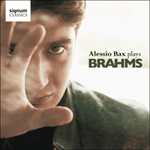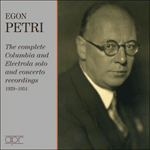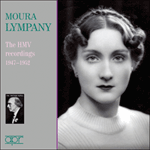
Welcome to Hyperion Records, a British classical label devoted to presenting high-quality recordings of music of all styles and from all periods from the twelfth century to the twenty-first.
Hyperion offers both CDs, and downloads in a number of formats. The site is also available in several languages.
Please use the dropdown buttons to set your preferred options, or use the checkbox to accept the defaults.
Brahms’s friends often referred to the result as the Hexenvariationen (Witchcraft Variations). ‘Variations on a theme by Paganini’ is in fact only Op 35’s subtitle. The main title, as if to emphasize its exploration of the technical aspects of keyboard virtuosity, is Studien für Pianoforte; and Brahms organized it in two complementary books, each of which contains the theme (from Paganini’s famous Caprice No 24 in A minor for solo violin), plus fourteen variations and a coda. The choice of theme is itself a direct challenge to Liszt, who had produced his own virtuoso recomposition of this Caprice in his Grandes études de Paganini (1838, revised 1851). Since Brahms’s time, many other composers have done their best or worst in variations on this theme, among them Rachmaninov, Lutoslawski, Boris Blacher and Andrew Lloyd Webber. The simplicity and clarity of the theme’s harmonic skeleton seems to afford each new composer almost unlimited scope for the imposition of his own personality.
Brahms’s variations open up a whole world of interpretative challenges, and take technical problems as the point of departure for expressive recreation. They include studies in double sixths, double thirds, huge leaps between the hands or with one hand. There are trills at the top of wide-spread chords, polyrhythms between the parts, octave studies, octave tremolos. Other variations explore staccato accompaniments against legato phrasing, glissandi, rapid contrary motion, and swooping arpeggios against held notes. During many of the variations the figuration is systematically transferred from right hand to left, and vice-versa. Not that each variation confines itself to one technical feature; several may be combined and in both books the final variation is welded to an extended three-part coda, covering an even larger range of difficult techniques and bringing each book to an end in scintillating style.
Generally speaking, in Book I the focus is on bravura writing. Technical demands occupy the music’s foreground, leaving scant space for Brahms’s habitual melodic developments; nevertheless, the delicate arabesques of the major-key variation 12, and the Hungarian accents of No 13, with its ‘gypsy’ glissandi, are delightful. Book II is somewhat gentler in character, with compositional virtues more predominant. The dreamy waltz of variation 4, the skittish arpeggios of No 6 with its ‘demonic’ crushed semitones, the ‘violinistic’ No 8 with its pizzicato effects, the cool nocturne of No 12 (the only variation in either book that strays from the orbit of A minor/major, into F), and the gently cascading thirds of No 13—these all combine to make Book II the more satisfying from a purely musical standpoint. Taken as a whole, however, the Paganini Variations is a stunning demonstration of Brahms’s compositional skills.
from notes by Calum MacDonald © 2010
Les amis de Brahms parlaient souvent de cette œuvre comme des Hexenvariationen (Variations de sorcières). En vérité, «Variations sur un thème de Paganini» n’est que le sous-titre de l’op. 35, dont l’intitulé principal est Studien für Pianoforte, comme pour faire ressortir l’exploration des aspects techniques de la virtuosité claviéristique; et Brahms les organisa en deux livres complémentaires renfermant chacun le thème dérivé du fameux Caprice no 24 en la mineur pour violon solo de Paganini, plus quatorze variations et une coda. Le choix du thème est en soi un défi direct à Liszt, qui avait produit sa propre refonte de ce Caprice dans ses Grandes études de Paganini (1838, révision 1851). Depuis l’époque de Brahms, bien d’autres compositeurs—tels Rachmaninov, Lutoslawski, Boris Blacher et Andrew Lloyd Webber—ont donné le meilleur (ou le pire) d’eux-mêmes dans des variations sur ce thème, dont la carcasse harmonique, simple et claire, semble permettre à chacun d’imposer presque à l’infini sa personnalité.
Les variations de Brahms ouvrent tout un monde de défis interprétatifs et partent des problèmes techniques pour se livrer à une recréation expressive. On y trouve des études de doubles sixtes, de doubles tierces, de sauts énormes partagés aux deux mains ou avec une seule main, des trilles en haut de larges accords, de la polyrythmie entre les parties, des études d’octaves et des trémolos d’octaves. D’autres variations explorent les accompagnements staccato sur fond de phrasé legato, les glissandi, le mouvement contraire rapide et les arpèges qui s’abattent en flèche contre des notes tenues. Très souvent, la figuration passe systématiquement de la main droite à la gauche et vice-versa. Toutes les variations ne se bornent pas à une seule caractéristique technique: elles peuvent en combiner plusieurs et, dans les deux livres, la dernière variation est soudée à une coda prolongée, à trois parties, qui couvre une palette de difficultés techniques encore plus large, closant chaque volume dans un style scintillant.
En règle générale, le Livre I met l’accent sur l’écriture de bravoure. Les exigences techniques, placées au premier plan, laissent peu d’espace pour les habituels développements mélodiques de Brahms—les délicates arabesques de la variation 12, en majeur, et les hungarismes de la no 13, avec ses glissandi «tziganes» n’en sont pas moins charmants. Le Livre II, un peu plus doux, insiste, lui, sur les mérites compositionnels. La langoureuse valse de la variation 4, les espiègles arpèges de la no 6, avec ses «démoniaques» demi-tons serrés, la «violonistique» no 8, avec ses effets de pizzicato, le frais nocturne de la no 12 (unique variation des deux livres à s’écarter de l’orbite de la mineur/majeur pour rejoindre fa), et les tierces doucement cascadantes de la no 13, tout cela se combine pour faire de ce livre le plus satisfaisant des deux, sur le plan purement musical—même si, à elles toutes, les Variations op. 35 nous offrent une étonnante démonstration des talents de compositeur de Brahms.
extrait des notes rédigées par Calum MacDonald © 2010
Français: Hypérion
Brahms’ Freunde pflegten diese Werke als Hexenvariationen zu bezeichnen. „Variationen über ein Thema von Paganini“ ist eigentlich nur der Untertitel des Opus 35. Der Haupttitel lautet, wohl zur Betonung der Erforschung der technischen Aspekte pianistischer Virtuosität, Studien für Pianoforte, und Brahms arrangierte sie in zwei sich ergänzenden Büchern, die beide das Thema (aus Paganinis berühmter Caprice Nr. 24 in a-Moll für Sologeige) sowie jeweils vierzehn Variationen und eine Coda enthalten. Die Wahl des Themas selbst ist ein direkter Angriff auf Liszt, der seine eigene virtuose Bearbeitung dieser Caprice in seinen Grandes études de Paganini (1838, revidiert 1851) veröffentlicht hatte. Auch viele Komponisten nach Brahms haben sich mit höchst unterschiedlichem Erfolg an Variationen über dieses Thema versucht, darunter Rachmaninoff, Lutoslawski, Boris Blacher und Andrew Lloyd Webber. Das einfache, klare harmonische Skelett dieses Themas scheint jedem neuen Komponisten einen fast unerschöpflichen Spielraum für den Ausdruck der eigenen Persönlichkeit zu bieten.
Brahms’ Variationen öffnen eine ganze Welt an Interpretationsmöglichkeiten und technischen Schwierigkeiten als Ausgangspunkt für entspannende Kreativität. Dazu gehören Studien in Doppelsextolen und Doppeltriolen, große Sprünge zwischen den Händen oder in einer Hand, Triller am Kopf weit gespannter Akkorde, Polyrhythmik zwischen einzelnen Teilen, Oktavstudien und Oktavtremoli. Andere Variationen erforschen Stakkatobegleitung zu Legatophrasierungen, Glissandi, schnelle Gegenläufe und weitschweifige Arpeggien gegen ausgehaltene Noten. In zahlreichen Variationen wird die Figuration systematisch von der rechten auf die linke Hand und umgekehrt übertragen. Doch sind die einzelnen Variationen nicht auf jeweils eine technische Besonderheit beschänkt. Vielmehr können mehrere miteinnder kombiniert werden, und in beiden Büchern ist die letzte Variation fest mit einer erweiterten dreiteiligen Coda verbunden, die einen noch größeren Bereich an technischen Schwierigkeiten bereithält und jedes Buch zu einem schillernden Abschluss bringt.
Allgemein lässt sich feststellen, dass Buch I sich auf bravourösen Kompositionsstil konzentriert, während die technischen Anforderungen im Vordergrund der Musik bleiben und kaum Spielrum für Brahms’ Gewohnheit melodischer Entwicklung lassen. Nichtsdestoweniger sind die zarten Arabesken in Variation Nr. 12 und die ungarischen Akzente in Nr. 13 mit ihren „zigeunerhaften“ Glissandi ein Ohrenschmaus. Buch II ist etwas zarter im Charakter mit stärker vorherrschenden kompositorischen Tugenden: Der verträumte Walzer von Variation Nr. 4; die rastlosen Arpeggien von Nr. 6 mit ihren „dämonisch“ zerdrückten Halbtönen; die „violinistische“ Nr. 8 mit ihren Pizzikato-Effekten; die kühle Nokturne von Nr. 12 (die einzige Variation in beiden Büchern, die von der Umlaufbahn von a-Moll/A-Dur nach F-Dur abweicht); und die zart kaskadierenden Dreiklänge von Nr. 13. All dies macht Buch II befriedigender vom rein musikalischen Standpunkt, doch insgesamt gesehen sind die Paganini-Variationen ein höchst staunenswerter Beweis von Brahms’ Meisterschaft.
aus dem Begleittext von Calum MacDonald © 2010
Deutsch: Henning Weber
 Brahms: Alessio Bax plays Brahms Brahms: Alessio Bax plays BrahmsThe Italian-born pianist and Leeds competition winner Alessio Bax returns with his third solo recital disc with a selection of highlights from Brahms' pianistic output, charting his development from the early Ballades through to the 'eight perfect ...» More |
 Egon Petri - The complete Columbia and Electrola solo and concerto recordings Egon Petri - The complete Columbia and Electrola solo and concerto recordingsEgon Petri (1881-1962) studied with Busoni and was perhaps his greatest disciple. In his fusion of intellect with an astonishing virtuoso technique he echoed his master and gives us today the clearest idea of Busoni’s own legendary pianism.» More |
 Wilhelm Backhaus - The complete acoustic and selected early electric recordings Wilhelm Backhaus - The complete acoustic and selected early electric recordingsAs one of the great pianists of the 20th century, Wilhelm Backhaus (1884-1969) needs no introduction. He recorded almost continuously from 1908 until his death, but this set, focusing on his earliest recordings, completes APR’s coverage (see also ...» More |
 Moura Lympany - The HMV Recordings, 1947-1952 Moura Lympany - The HMV Recordings, 1947-1952Moura Lympany (1916-2005) was the last of the major Matthay pupils and she started working with him in 1937 when he was already 79. In 1938 she shot to international fame when she came second to Emil Gilels in the Queen Elisabeth competition. A br ...» More |

